Statistical and Rule Learning
1/35
There's no tags or description
Looks like no tags are added yet.
Name | Mastery | Learn | Test | Matching | Spaced |
|---|
No study sessions yet.
36 Terms
The complexity of human cognition
Complexity of human cognition may be unique among all species. • It is defined by complex sequences and hierarchical structure. • It spans several cognitive domains, e.g. language, social reasoning, action sequencing. • Corballis, 2007
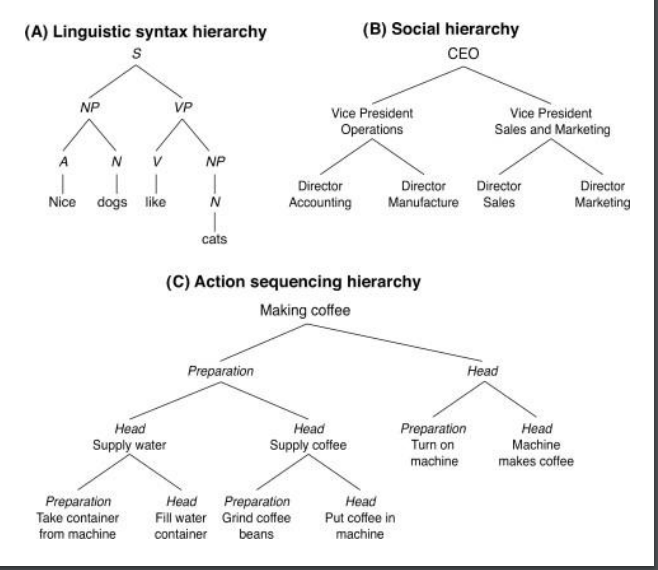
Why do we investigate structure?
• … to understand cognition in development, • … in clinical populations, • … across species, • … in the brain.
How do we test structure?
In normal behavior, complexity is expressed in combination with a range of other factors (e.g., perceptual, symbolic, intentional).
Research paradigms- how do study this
Serial reaction time (SRT) • Word segmentation • Artificial grammar learning (AGL)
Serial Reaction Time (SRT) Learning
Sequence motor skill learning (Nissen & Bullemer, 1987). • Usually training of a fixed sequence, e.g. 2-3-1-4-3-2-4-1-3-4-2-1. • Reaction time (RT) is measured. • RT goes up if sequence is learned, then disrupted, e.g. by presenting random sequences. • RT difference between sequence and random = measure of learning. • Demonstrated in children aged 4. • Using eye-tracking, in children aged 7-8 months.
Some of the species that can learn in SRT tasks: • Humans • Chimpanzees • Rhesus monkeys • Rats • Mice • Pigeons
fMRI analyses of SRT learning
Schendan et al., 2003 • Contrast: structured sequence trial blocks vs. random trial blocks • Implicit vs. explicit conditions • Involvement of the medial temporal lobe (MTL; hippocampus(!) and surrounding regions) in both conditions (implicit below). See also Seok & Cheong (2019). • However, HM and
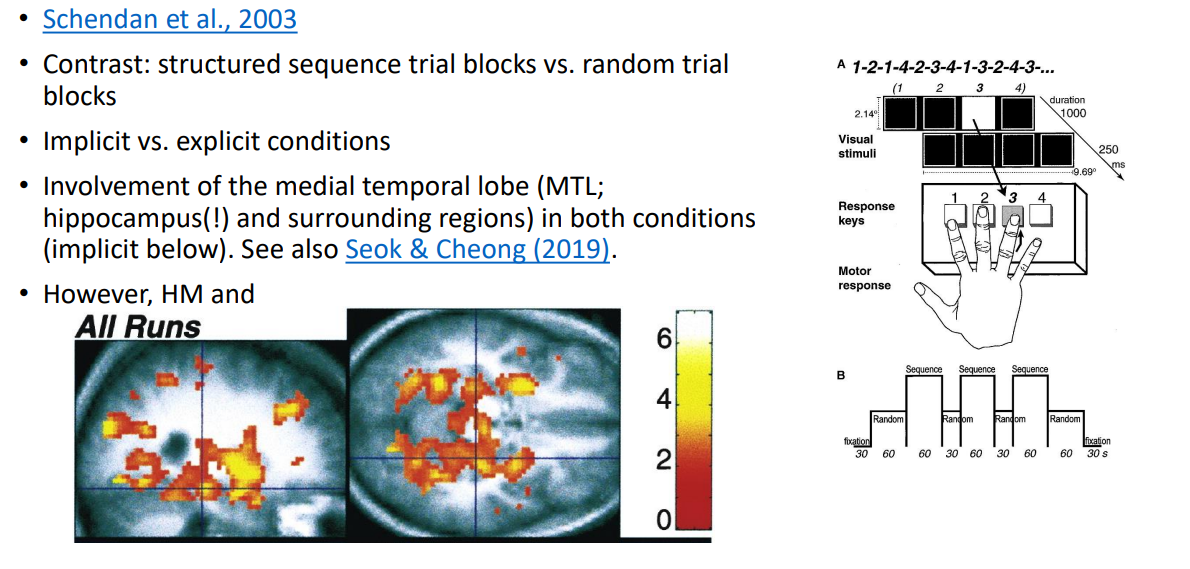
The role of the medial temporal lobe
MTL relevant for sequencing temporal information. • Activation increased with complexity of learning: • First-order learning: A-B-A-D-B-C-D- C-A-D-B-C • Remembering previous item sufficient for learning • A followed by D 67% of the time • A followed by B 33% of the time • A followed by C 0% of the time • Second order learning: A-B-A-D-B-C-D-A-C-B-D-C • Remembering previous item insufficient • A followed by each other stimulus 25% of the time • B-A followed by D 100% of the time
What about amnesia?
HM could learn new implicit skills… (Milner 1962) • Can people with amnesia learn SRT sequences? • Curran (1997): “Despite seemingly normal learning effects on average, the results suggest that amnesic patients do not learn higher-order information as well as control subjects. These results suggest that amnesic patients have an associative learning impairment, even when learning is implicit, and that the medial temporal lobe and/or diencephalic brain areas typically damaged in cases of amnesia normally contribute to implicit sequence learning.”
Involvement of basal ganglia
Basal ganglia are a group of subcortical structures part of the diencephalon (interbrain). It is strongly connected with the brainstem and the cerebral cortex. • Associated with motor control, decision making, habitual behaviors and emotions. • Basal ganglia lesions, but not hippocampal lesions, impaired SRT learning in rats. • Meta-analysis of 20 studies (Janacsek et al., 2020) suggests basal ganglia activation is most relevant. • More on possible hippocampus involvement (including “competition accounts”) in Batterink et al. (2019).

SRT learning in clinical populations
• SRT learning weaker in dyslexia and developmental language disorder.
Word segmentation
8-month olds use statistical information to segment words (Saffran et al., 1996). • Learning occurs in auditory and visual modalities.
Transitional probabilities
Stimuli that follow each other often belong together
Word segmentation in non-humans
Demonstrated in cottontop tamarins and zebra finches.
fMRI analyses of word segmentation
• McNealy et al., 2006 • Both auditory cortices respond to properties of the stimuli (e.g. stressed vs. non-stressed). • Activation in the left superior temporal gyrus during listening associated with better performance in the decision task.
Wernicke area

fMRI analyses of word segmentation
Right striatum, left hippocampus, lateral occipital lobes and left ventral occipito-temporal cortex associated with visual word segmentation (Turk-Browne et al., 2008)
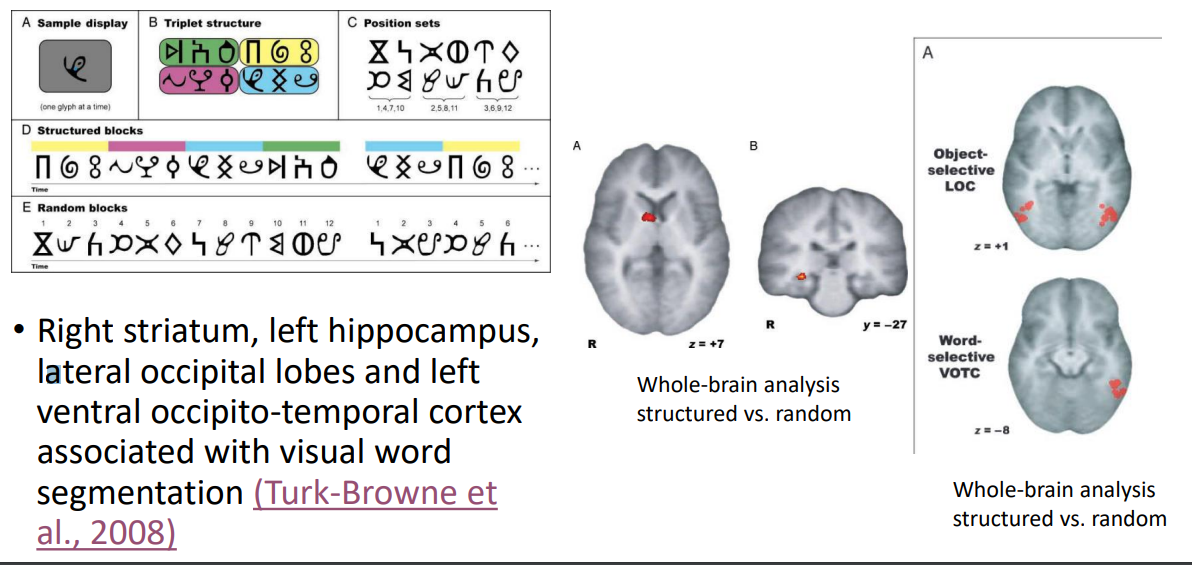
fMRI analyses of word segmentation
Non-adjacent (higher order statistical processing) • Words: ba_te, gu_do, pi_ra, ke_du, lo_ki • Filler syllables di, ku, to, pa • Stimuli e.g. badite, bakute, batote, bapate • Learning associated with activation in the LIFG (Broca’s area)
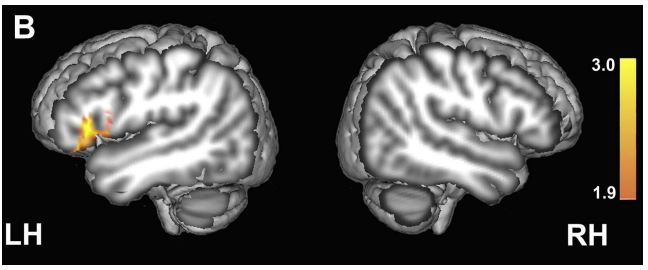
More complex behavior…
Sequence and word learning not all there is to behavior: • Generalization: applying knowledge to novel situations, for example in language: • “They are under fire for demanding that staff give fingerprints and samples of their handwriting to help identify who wrote to a family alerting them to failings in care that contributed to a patient’s death.” • “The a two hope boats.” • “The man the lion ran.
Very complex behavior…
• Hierarchical processing: • *“The man the lion ran.” • “The [man the lion chased] ran.” • Hierarchical processing allows great complexity in behavior (Chomsky, Hauser, & Fitch, 2002). • A “grammar” of higher cognition?
Artificial grammar learning (AGL)
Learning of complex pattern rules • The typical AGL experiment consists of two phases: • Training phase: sequences generated by a set of rules (“target grammar”) • Test phase: classification of grammatical and violation sequences • Decision patterns (acceptance/rejection of test sequences) provide insight into syntactic representations
Artificial grammar learning (AGL)
Reber, 1967 • Target grammar a “Markov transition grammar” • Grammatical e.g., TPPTS, VVS, VXCPXVS • Ungrammatical e.g., TPTPS, VXVTP, *XVPTS • After training with grammatical sequences, above chance performance in test phase.
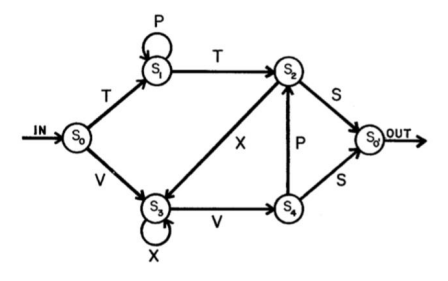
Artificial grammar learning (AGL) non words
Possible to control for language content: • Stimuli can be non-words (no semantics), nonlinguistic sounds (no phonology), or in different sensory modalities. • Variation tests generalization (Stobbe et al., 2012): • a) training stimuli • b) test stimuli • c) new colours • d) rotated stimuli • e) scrambled stimuli • f) greyscale stimuli • e) extensions • h) foil stimuli
Artificial grammar learning
Reber-task elicits activation in Broca’s area (Petersson, 2004). • Contrast: ungrammatical - grammatical
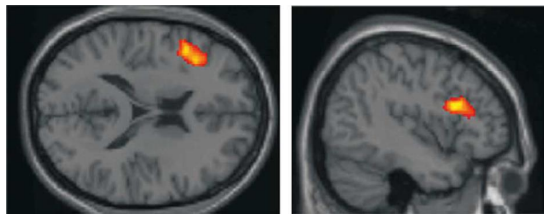
AGL in infants
Demonstrated in 7-month olds (Marcus et al., 1999). • Relatively simple grammar: dissociation between AAB- and ABAstructured sequences, e.g. ga-ti-ti vs. ga-ti-ga. • After habituation with one type, longer looking times for the other type. • However, generalization to sequences with novel syllables.
AGL in non-humans
Demonstrated in finches and cottontop tamarins. • Finches learned ABB vs. ABA discrimination. • Cotton-top tamarin learning was also structurally limited.
Hierarchical processing in AGL
Fitch & Hauser, 2004 • Comparison of human adults and cotton-top tamarins. • Two grammars contrasted: Finite state transition grammar ABn and “phrase structure” hierarchical grammar A nB n • S -> A[S]B • Finite state: [AB][AB], [AB][AB][AB], [AB][AB][AB][AB] • Phrase structure: A[AB]B, A[A[AB]B]B, A[A[A[AB]B]B]B • Monkeys learned ABn , but not A nB n • Humans learned both.
![<p>Fitch & Hauser, 2004 • Comparison of human adults and cotton-top tamarins. • Two grammars contrasted: Finite state transition grammar ABn and “phrase structure” hierarchical grammar A nB n • S -> A[S]B • Finite state: [AB][AB], [AB][AB][AB], [AB][AB][AB][AB] • Phrase structure: A[AB]B, A[A[AB]B]B, A[A[A[AB]B]B]B • Monkeys learned ABn , but not A nB n • Humans learned both.</p>](https://knowt-user-attachments.s3.amazonaws.com/cd4561c0-81fa-4370-b3bd-7873fd21b5a1.png)
fMRI investigation of hierarchical AGL
Friederici et al., 2006 • Violations of both grammars elicited left frontal gyrus activation. • Finite state grammar: left frontal operculum • Phrase structure grammar: Left frontal operculum and Broca’s area
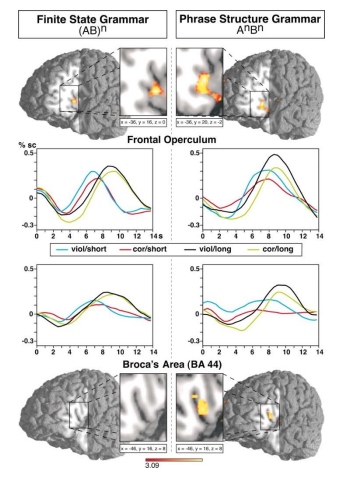
A variation….
Stimulus-to-stimulus mapping to avoid simple “counting” strategies (Bahlmann et al., 2008). • Difficult to learn – feedback and “start small” strategy used for learning.
fMRI investigation of hierarchical AGL
Hierarchical contrasted against transition (adjacent) grammar associated with Broca’s area, premotor cortex and basal ganglia activations

AGL in aphasia
• Poorer AGL performance measured in aphasia with Broca’s area lesion, compared to healthy controls: • Dominey and Lelekov (2000) tested learning of a grammar generating letter strings. • Christiansen et al. (2010) used non-linguistic stimuli and matched controls for non-verbal intelligence. • Zimmerer et al. (2014, 2015) used a lesion control group and analyzed individual differences.
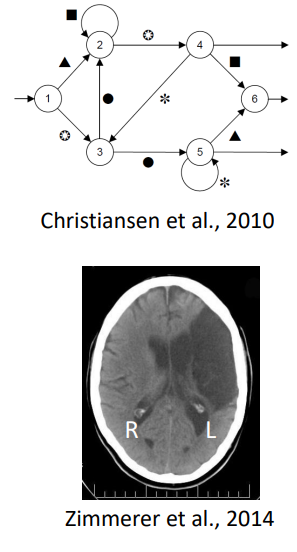
Broca’s area: a hub of complexity?
• Associated with complex language, music and action (Fadiga et al., 2010) • Phylogenetically (evolutionary) novel. • However (Federenko & Varley, 2016): • People with lesion to Broca’s area have demonstrated complex behavior. • Increasing evidence for other (more posterior) areas involved in complex cognition.
Complex thought in severe aphasia
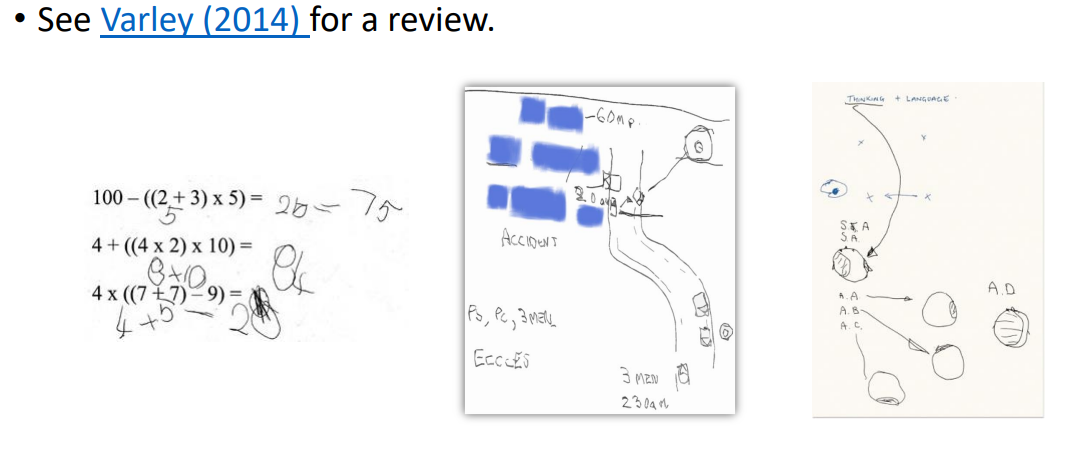
Summary
Different sequence complexity = different brain activation • Medial temporal lobe (incl. hippocampus) + basal ganglia involved in motor sequence learning • Temporal cortex – word segmentation • Broca’s and surrounding areas involved in more complex statistical and hierarchical processing • Evolutionary more novel areas responsible for more complex processing • Implicit vs. explicit: a difficult distinction • Difficult to determine how an artificial grammar is processed
Connectionist models
Dell’s spreading-activation model of lexical representation (e.g. 1999). • “Connectionist models”n • Activation spreads along nodes (bidirectional models). • Connections have different “weights”. • Each node has an activation threshold. • Connections can change on the basis of experience. • “Models are metaphors”
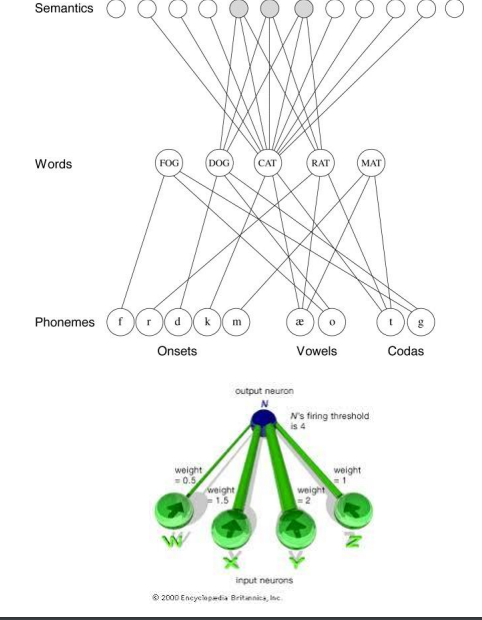
Supervised machine learning
Making decisions based on stimulus features • Often based on categorization: • Object • Colour • Action • Individual • Speech sound • Word • etc. • Too complex to be manually programmed • Network teaches itself based on feedback (supervised learning)
Supervised machine learning
Axes: features • Concrete, e.g. Color, size • Abstract, e.g. Object category, function • Colours: class (or category) • Supervized machine learning asjusts a neural network to approximate a good solution

Learning rate
The amount of adjustment in each step • Too small: too long to learn • Too fast: can overshoot the optimum
